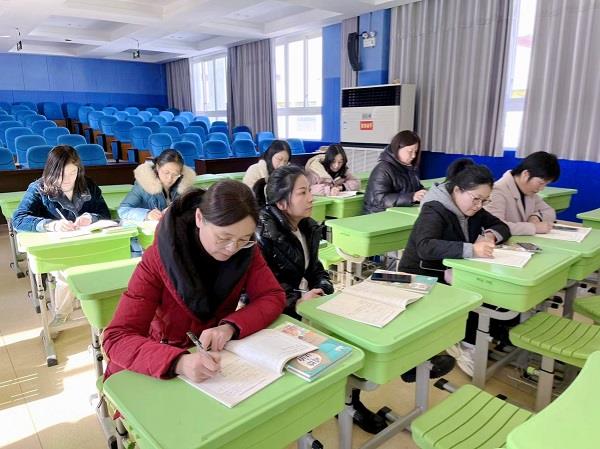“先学后教”强调学生学的过程,关注学生学习意识的培养,促进终身学习。本课是以学生的合作先学为前提,教师针对学生先学的反馈情况找到切入点,整体组织调控,引导学生在课堂学习过程中主动地获取英语知识,掌握言语技能,形成学习能力。
先学后教 精彩纷呈
——《It was there!》教学设计方案
江苏省启东实验小学 范长春
【教学设计概述】
“先学后教,以学定教”是当前我们讨论的热点话题之一。“先学后教”中的先学不仅仅是自学,后教也不是不教。它从教学的顺序来看,是“学”先于“教”,从教与学的主次来看,是“学”重于“教”,教师“以学定教”,根据学生学的情况确定自己的教学内容。
本课为《牛津小学英语It was there!》第一课时语篇教学内容。主要谈论的是体育运动日那天,苏海和苏阳寻找相机和胶卷的故事。教学目标是让学生能正确理解语篇内容,会读,并能复述课文;学生能初步认知和了解一般过去时;学生能听得懂、会读、会说和会写单词:was, were, film, moment, running race, Sports Day, excited, exciting,ground;学生能听得懂、会读、会说和会写句子:Where is it? It’s … It isn't there. It was there a moment ago. Where are they? They’re… They aren’t there. They were here just now.本课需要培养的能力目标是提高学生自主学习和合作探究的能力。
本课词汇较多,篇幅较长,还有一个时态——一般过去时的教学,容量较大!在课堂40分钟有限的时间内是否能将课文上完、上好?我采用如下几个步骤:Preview(课前先学)——Preparation(先学展示)——Presentation(设境导学)——Practice(探究练能)——Production(生成运用)——Progress(拓展延伸),学生在教师的引导下积极参与课堂活动,他们自主学习,合作探究,在交流和沟通中理解课文内容,并能学以致用,纷呈出别样的精彩!
【教学过程】
Step1. Preview(课前先学)
<先学试练>
一、was, were的原形是什么?常用于什么时态?
was, were是______动词的过去式。was的原形是________或________;were的原形是________。was, were常用于_________时。表示过去的时间状语有: __________、_________。
根据句意,填上合适的be动词完成句子。
1. My CD Walkman ______ in the desk now.
2. Look, Lily and Lucy ______ reading in the library.
3. Miss Li ______here a moment ago.
4. Su Hai ______ not here now. She and her mother ______ here just now.
5. Where ______my apples?I can’t find them now.
6. ---I can’t find my shirt. Where ______ it now?
--- ______ it on your bed?
---No, it ______ there a moment ago.
二、读一读,写一写!(你能查找工具书,读出下列单词并写出它的意思吗?)
Sports Day: excited:
just now: a moment ago:
running race: film:
ground: exciting:
三、阅读短文,判断正(T)误(F)。
( ) 1. It is Sports Day.
( ) 2. Su Hai and Su Yang are watching a football game.
Step2. Preparation(先学展示)
1. 课前,教师提醒组长:请组长在课堂学习过程中观察好本组成员的各项表现,在小组合作评价表的相应栏目中画J!(每个学习小组4~6人,一人为组长。)
【设计意图】小组合作评价表是贯穿于学生整个学期的学习过程,每节课前发下给班级每个组的组长,让组长在在课堂学习过程中观察好本组成员的各项表现,然后在相应的栏目中画J!孩子们如果要得到笑脸,就得全身心地投入到学习中,尽力完成课上的目标任务,这对他们来说是一种鼓动,也是一种激励,促使他们全身心地投入到课堂活动中。
2. T: Class begins! Good morning, children!
S: Good morning, Miss Fan.
T: Would you like to play a game with me?
Ss: OK.
T: Look, what’s this?
Ss: It’s a flower.
T: Where is the flower now?
S: It’s in your hand.
T: Yes. Now let’s play the game” Pass the flower”. When you hear the music, please pass the flower, when the music stops, you should stop, too. Are you ready?
Ss: Yes.(击鼓传花游戏)
T: (鼓声响起,音乐停,老师对着全班同学)Is the flower in my hand?
S: No.
T: Where is the flower now?
S: It’s in A’s hand.
T: Yes. It’s in A’s hand now. It was in my hand just now/a moment ago.(板书,并带读,让学生猜测just now/a moment ago的意思,检测先学情况)
(继续游戏)
T: Where is the flower now?
S: It’s in B’s hand.
T: Is it in A’s hand?
S: No.
T: It was there just now/ a moment ago.
T: Now I want to give you more flowers.(给孩子们一束花,开展击鼓传花游戏)Where are the flowers now?
S: They are in C’s hand.
T: (继续游戏)Where are the flowers now?
S: They are in D’s hand.
T: Are they in C’s hand?
S: No.
T: They were there just now/ a moment ago.
【设计意图】一上课,我让孩子们做了一个“击鼓传花”的游戏,目的在于:一、活跃气氛,激发学生的学习兴趣;二、导出本课新授句型It was there a moment age. They were here just now.让学生在上课伊始对本课所学就有个初步的认知。有老师认为,本课是语篇教学,我们要注重语篇呈现的整体性。我把这两个句型拿出来讲解,其实并没有将语篇割裂,干扰学生的理解,而是为了更好地、更完整地呈现语篇而做的铺垫。因为在语篇教学之前,我们需要把干扰学生理解的知识点处理掉,这里很明显是过去式was和were,以及句型It was there a moment age. They were here just now.会影响学生的理解。所以,我设计了这一游戏,巧妙地将重难点一一突破。
3. T: Are you happy?
S: Yes.
T: Shall we play another game?
S: Great!
T: Here are two pictures. Look carefully and try to find the differences.
S: …is/are …now.
…was/were…a moment ago.
T: So much for the games. Boys and girls, at this lesson, we’re going to learn this dialogue.
(板书It was there!) Can you read it?
Ss: It was there!
T: Good! I know you are good at previewing. First let’s check the answers together!
Ss: OK.
4. 检测 <先学试练> 一
检测 <先学试练> 二
T: Can you read these words or phrases? Please read in your groups!(小组内朗读,然后请小组全体成员在全班展示,检测1~2组后,发现excited和exciting两个词比较难读,学生掌握情况欠佳,教师及时领读,学生跟读巩固。)
T: Now let's look and say!(快速呈现一个单词或词组,让学生大声说出。检测学生的单词掌握情况。)
检测 <先学试练>三
( ) 1. It is Sports Day.
( ) 2. Su Hai and Su Yang are watching a football game.
【设计意图】这一步是基于课前先学产生的。我在课前编写好先学提纲,让学生明确前置学习的内容,进行先学试练;然后在小组内交流,各抒己见,通过“兵教兵”等互助方式进行。我在教室内“巡回观看”, 对先学活动进行整体组织和调控,并对个别小组和后进生进行有针对性的帮助。当发现有些题目是学生之间通过讨论无法解决的,我及时作出指导。
Step2&3. Presentation(设境导学)&Practice(探究练能)
1. T: (和学生校正答案后,呈现书本图片,让孩子们看图自由说话)
<随堂实练> 一: Talk about the picture.
【设计意图】前言部分是对本课对话内容的总结,我让学生看图谈图,想怎样表达就怎样表达,培养孩子的观察能力,想象能力以及用英语交际的能力。然后再呈现导言,让学生观察其中的两个新词excited和exciting,总结其不同的用法。
T: It is Sports Day. All the students are vey excited. They are w.atching the running race. It’s very exciting.Here are two words: excited and exciting. What’s the difference between them?
S: …
T: 总结We usually say somebody is excited. Something is exciting.
<随堂实练> 二 :用excited或exciting填空。
(1)The film(电影) is very _________.
(2) My mother is __________.
(3) This is an ________ running race.
(4) Are Su Hai and Su Yang ________?
2. T: (出示Su Yang and Su Hai图)Are they excited?
S: No.
T: Why? Here are two choices. Let’s read the dialogue quickly and quietly, and then circle the answer.
A. Su Hai and Su Yang can’t find their books.
B. Su Hai and Su Yang can’t find their camera and films.
T: Which one is right?
Ss: B
T: So Su Hai and Su Yang are looking for the camera and films. (板书look for sth.)
3. T: Where are the camera and the films now? Where were they just now? Please read the dialogue in your groups and underline the answers. (小组合作讨论照相机和胶卷刚才和现在分别在哪里?)
T: Let’s check. Where was the camera a moment ago?(边说边板书)
Ss: It was in Su Hai’s bag.
T: Where’s the camera now?
Ss: It’s in Su Yang’s bag.
2. T: What about films? Where were they just now?
Ss: They were in Su Yang’s bag.
T: Where are they now?
Ss: They’re on the ground.
3. T: Now let’s listen and read. Pay attention to your pronunciation and intonation.(跟录音读、齐读、分角色读)
【设计意图】课文阅读分3个步骤完成。第一步:Read and circle the correct answer.选择题的设置引导学生快速阅读,了解课文大意;第二步:Read and underline the sentences.让孩子仔细阅读,弄清文中的camera和films刚才和现在分别在哪里;了解一般现在时和一般过去时的用法和区别;第三步:Listen and read.让学生跟读并体会录音中的语音语调,然后再分角色朗读,培养学生的合作和自主学习能力。
Step4. Production(生成运用)
T: You can read well. Can you retell the story well, too? You can prepare in your groups.
<随堂实练>三: Retell the story
Ss: 反馈
【设计意图】课上到这里,学生们基本能在语境中整体感受语篇,并能理解语篇的意义,教师是否能通过有意义的语言输入来激活学生有意义的语言输出?学生是否能体验和运用语言?如果能,我们的教学目标就基本达成了!于是我安排了在朗读基础上的Story Time环节,我让学生复述课文,方法是根据图片和黑板上的板书,学生的复述有了依据,降低了难度,他们跳一跳,就能摘到 “大苹果”,参与热情极高。
Step 5 Progress(拓展延伸)
T: You all did a good job. Now I want to share my growing diary with you! Let’s listen!
T: Twenty years ago, I was a student. I was 15 years old. I was not tall. My hair was short. There were four people in my family. There was only one TV set in my small house.
Now, I am an English teacher. I am tall. My hair is long. There are three people in my family. There are two TV sets in my big house.
T: Would you like to share your growing diary with us? Please write!
<拓展活练> My growing diary
years ago, I years old. I _____a baby(婴儿). I___________. My _________.
There ______________________________________.
Now, I years old. I _______ a student. I________________. My _________________. There _____________________________________.
(学生写完后,在全班展示,学生互评。)
【设计意图】progress部分,我先让孩子们分享我的成长日记,其实是向孩子们提供了写作的模板,然后让他们根据我所给出的提示,记录他们自己的成长日记——“My growing diary”。通过小时候和现在的对比,学生们训练了一般过去时和一般现在时两种时态。学生们通过书写和展示,促使自己自己反思本节课的所学所得。这一环节的设置促使学生在有限的课堂时间里思考得更多,从而更好地拓展学生的知识面,开阔英语学习的眼界,也能让不同层次的学生都能得到更好的发展。
Homework:
1. Listen and read the dialogue.
2. Make a new dialogue according to the text.
【教后反思】
“先学后教”,是对传统教学方法“先教后学”的否定,它将学生的学放在第一位。教学过程是师生共同参与、互动的动态发展的过程。学生有了 “先学”为基础,因而课堂上有更多的声音 “嚷嚷”,课堂不再是死气沉沉,而是学生们高谈阔论的场所,孩子们在思维的碰撞中习得新知,提高能力。
本课上完,我感慨万千!在Presentation(设境导学)这一教学环节中,我让学生自主先学excited和exciting这两个词,说出它们用法的区别,学生们各抒己见,一个学生大声说:“excited是过去式;而exciting是现在进行时。”听课的老师说:“我们都为你捏了一把汗!看你怎么引导到正确的用法上?”我笑着说:“我一点都不着急,这帮小鬼聪明着呢!他们会帮我解决。”果然有学生接着说:“excited意思是激动的,兴奋地;而exciting是令人激动的,令人兴奋的”。又有学生站起来回答:“All the students are vey excited. 是说 ‘人’激动;而It’s very exciting.这句话中的it 是指前一句话中的the running race.也就是说比赛令人激动。”学生们听到这,都有了思维的顿悟,不约而同地说“哦!人要说excited,物要说exciting”于是我笑眯眯地肯定他们,并总结:“We usually say somebody is excited. Something is exciting.”瞧!孩子们自主先学,主动探究,教师启发,诱导,总结;学生质疑,观察,发现,陈述,学习速度极快,我相信通过孩子们讨论得出的结论不容易遗忘,我们适度放手,何乐而不为呢?
当然孩子们自主先学,合作探究的能力不是凭空突然出现的,它离不开教师在日常教学中潜移默化的影响,愿所有的老师都能转变理念,“先学后教”,给予学生能力成长的机会!
让我们共勉:释放时间,让学生们讨论!腾出空间,让学生们思考!允许冲突,让学生们发现!适时引导,让学生们顿悟!
本文发表于《河北教育》
先学后教 精彩纷呈
——《It was there!》教学设计方案
江苏省启东实验小学 范长春
【教学设计概述】
“先学后教,以学定教”是当前我们讨论的热点话题之一。“先学后教”中的先学不仅仅是自学,后教也不是不教。它从教学的顺序来看,是“学”先于“教”,从教与学的主次来看,是“学”重于“教”,教师“以学定教”,根据学生学的情况确定自己的教学内容。
本课为《牛津小学英语It was there!》第一课时语篇教学内容。主要谈论的是体育运动日那天,苏海和苏阳寻找相机和胶卷的故事。教学目标是让学生能正确理解语篇内容,会读,并能复述课文;学生能初步认知和了解一般过去时;学生能听得懂、会读、会说和会写单词:was, were, film, moment, running race, Sports Day, excited, exciting,ground;学生能听得懂、会读、会说和会写句子:Where is it? It’s … It isn't there. It was there a moment ago. Where are they? They’re… They aren’t there. They were here just now.本课需要培养的能力目标是提高学生自主学习和合作探究的能力。
本课词汇较多,篇幅较长,还有一个时态——一般过去时的教学,容量较大!在课堂40分钟有限的时间内是否能将课文上完、上好?我采用如下几个步骤:Preview(课前先学)——Preparation(先学展示)——Presentation(设境导学)——Practice(探究练能)——Production(生成运用)——Progress(拓展延伸),学生在教师的引导下积极参与课堂活动,他们自主学习,合作探究,在交流和沟通中理解课文内容,并能学以致用,纷呈出别样的精彩!
【教学过程】
Step1. Preview(课前先学)
<先学试练>
一、was, were的原形是什么?常用于什么时态?
was, were是______动词的过去式。was的原形是________或________;were的原形是________。was, were常用于_________时。表示过去的时间状语有: __________、_________。
根据句意,填上合适的be动词完成句子。
1. My CD Walkman ______ in the desk now.
2. Look, Lily and Lucy ______ reading in the library.
3. Miss Li ______here a moment ago.
4. Su Hai ______ not here now. She and her mother ______ here just now.
5. Where ______my apples?I can’t find them now.
6. ---I can’t find my shirt. Where ______ it now?
--- ______ it on your bed?
---No, it ______ there a moment ago.
二、读一读,写一写!(你能查找工具书,读出下列单词并写出它的意思吗?)
Sports Day: excited:
just now: a moment ago:
running race: film:
ground: exciting:
三、阅读短文,判断正(T)误(F)。
( ) 1. It is Sports Day.
( ) 2. Su Hai and Su Yang are watching a football game.
Step2. Preparation(先学展示)
1. 课前,教师提醒组长:请组长在课堂学习过程中观察好本组成员的各项表现,在小组合作评价表的相应栏目中画J!(每个学习小组4~6人,一人为组长。)
【设计意图】小组合作评价表是贯穿于学生整个学期的学习过程,每节课前发下给班级每个组的组长,让组长在在课堂学习过程中观察好本组成员的各项表现,然后在相应的栏目中画J!孩子们如果要得到笑脸,就得全身心地投入到学习中,尽力完成课上的目标任务,这对他们来说是一种鼓动,也是一种激励,促使他们全身心地投入到课堂活动中。
2. T: Class begins! Good morning, children!
S: Good morning, Miss Fan.
T: Would you like to play a game with me?
Ss: OK.
T: Look, what’s this?
Ss: It’s a flower.
T: Where is the flower now?
S: It’s in your hand.
T: Yes. Now let’s play the game” Pass the flower”. When you hear the music, please pass the flower, when the music stops, you should stop, too. Are you ready?
Ss: Yes.(击鼓传花游戏)
T: (鼓声响起,音乐停,老师对着全班同学)Is the flower in my hand?
S: No.
T: Where is the flower now?
S: It’s in A’s hand.
T: Yes. It’s in A’s hand now. It was in my hand just now/a moment ago.(板书,并带读,让学生猜测just now/a moment ago的意思,检测先学情况)
(继续游戏)
T: Where is the flower now?
S: It’s in B’s hand.
T: Is it in A’s hand?
S: No.
T: It was there just now/ a moment ago.
T: Now I want to give you more flowers.(给孩子们一束花,开展击鼓传花游戏)Where are the flowers now?
S: They are in C’s hand.
T: (继续游戏)Where are the flowers now?
S: They are in D’s hand.
T: Are they in C’s hand?
S: No.
T: They were there just now/ a moment ago.
【设计意图】一上课,我让孩子们做了一个“击鼓传花”的游戏,目的在于:一、活跃气氛,激发学生的学习兴趣;二、导出本课新授句型It was there a moment age. They were here just now.让学生在上课伊始对本课所学就有个初步的认知。有老师认为,本课是语篇教学,我们要注重语篇呈现的整体性。我把这两个句型拿出来讲解,其实并没有将语篇割裂,干扰学生的理解,而是为了更好地、更完整地呈现语篇而做的铺垫。因为在语篇教学之前,我们需要把干扰学生理解的知识点处理掉,这里很明显是过去式was和were,以及句型It was there a moment age. They were here just now.会影响学生的理解。所以,我设计了这一游戏,巧妙地将重难点一一突破。
3. T: Are you happy?
S: Yes.
T: Shall we play another game?
S: Great!
T: Here are two pictures. Look carefully and try to find the differences.
S: …is/are …now.
…was/were…a moment ago.
T: So much for the games. Boys and girls, at this lesson, we’re going to learn this dialogue.
(板书It was there!) Can you read it?
Ss: It was there!
T: Good! I know you are good at previewing. First let’s check the answers together!
Ss: OK.
4. 检测 <先学试练> 一
检测 <先学试练> 二
T: Can you read these words or phrases? Please read in your groups!(小组内朗读,然后请小组全体成员在全班展示,检测1~2组后,发现excited和exciting两个词比较难读,学生掌握情况欠佳,教师及时领读,学生跟读巩固。)
T: Now let's look and say!(快速呈现一个单词或词组,让学生大声说出。检测学生的单词掌握情况。)
检测 <先学试练>三
( ) 1. It is Sports Day.
( ) 2. Su Hai and Su Yang are watching a football game.
【设计意图】这一步是基于课前先学产生的。我在课前编写好先学提纲,让学生明确前置学习的内容,进行先学试练;然后在小组内交流,各抒己见,通过“兵教兵”等互助方式进行。我在教室内“巡回观看”, 对先学活动进行整体组织和调控,并对个别小组和后进生进行有针对性的帮助。当发现有些题目是学生之间通过讨论无法解决的,我及时作出指导。
Step2&3. Presentation(设境导学)&Practice(探究练能)
1. T: (和学生校正答案后,呈现书本图片,让孩子们看图自由说话)
<随堂实练> 一: Talk about the picture.
【设计意图】前言部分是对本课对话内容的总结,我让学生看图谈图,想怎样表达就怎样表达,培养孩子的观察能力,想象能力以及用英语交际的能力。然后再呈现导言,让学生观察其中的两个新词excited和exciting,总结其不同的用法。
T: It is Sports Day. All the students are vey excited. They are w.atching the running race. It’s very exciting.Here are two words: excited and exciting. What’s the difference between them?
S: …
T: 总结We usually say somebody is excited. Something is exciting.
<随堂实练> 二 :用excited或exciting填空。
(1)The film(电影) is very _________.
(2) My mother is __________.
(3) This is an ________ running race.
(4) Are Su Hai and Su Yang ________?
2. T: (出示Su Yang and Su Hai图)Are they excited?
S: No.
T: Why? Here are two choices. Let’s read the dialogue quickly and quietly, and then circle the answer.
A. Su Hai and Su Yang can’t find their books.
B. Su Hai and Su Yang can’t find their camera and films.
T: Which one is right?
Ss: B
T: So Su Hai and Su Yang are looking for the camera and films. (板书look for sth.)
3. T: Where are the camera and the films now? Where were they just now? Please read the dialogue in your groups and underline the answers. (小组合作讨论照相机和胶卷刚才和现在分别在哪里?)
T: Let’s check. Where was the camera a moment ago?(边说边板书)
Ss: It was in Su Hai’s bag.
T: Where’s the camera now?
Ss: It’s in Su Yang’s bag.
2. T: What about films? Where were they just now?
Ss: They were in Su Yang’s bag.
T: Where are they now?
Ss: They’re on the ground.
3. T: Now let’s listen and read. Pay attention to your pronunciation and intonation.(跟录音读、齐读、分角色读)
【设计意图】课文阅读分3个步骤完成。第一步:Read and circle the correct answer.选择题的设置引导学生快速阅读,了解课文大意;第二步:Read and underline the sentences.让孩子仔细阅读,弄清文中的camera和films刚才和现在分别在哪里;了解一般现在时和一般过去时的用法和区别;第三步:Listen and read.让学生跟读并体会录音中的语音语调,然后再分角色朗读,培养学生的合作和自主学习能力。
Step4. Production(生成运用)
T: You can read well. Can you retell the story well, too? You can prepare in your groups.
<随堂实练>三: Retell the story
Ss: 反馈
【设计意图】课上到这里,学生们基本能在语境中整体感受语篇,并能理解语篇的意义,教师是否能通过有意义的语言输入来激活学生有意义的语言输出?学生是否能体验和运用语言?如果能,我们的教学目标就基本达成了!于是我安排了在朗读基础上的Story Time环节,我让学生复述课文,方法是根据图片和黑板上的板书,学生的复述有了依据,降低了难度,他们跳一跳,就能摘到 “大苹果”,参与热情极高。
Step 5 Progress(拓展延伸)
T: You all did a good job. Now I want to share my growing diary with you! Let’s listen!
T: Twenty years ago, I was a student. I was 15 years old. I was not tall. My hair was short. There were four people in my family. There was only one TV set in my small house.
Now, I am an English teacher. I am tall. My hair is long. There are three people in my family. There are two TV sets in my big house.
T: Would you like to share your growing diary with us? Please write!
<拓展活练> My growing diary
years ago, I years old. I _____a baby(婴儿). I___________. My _________.
There ______________________________________.
Now, I years old. I _______ a student. I________________. My _________________. There _____________________________________.
(学生写完后,在全班展示,学生互评。)
【设计意图】progress部分,我先让孩子们分享我的成长日记,其实是向孩子们提供了写作的模板,然后让他们根据我所给出的提示,记录他们自己的成长日记——“My growing diary”。通过小时候和现在的对比,学生们训练了一般过去时和一般现在时两种时态。学生们通过书写和展示,促使自己自己反思本节课的所学所得。这一环节的设置促使学生在有限的课堂时间里思考得更多,从而更好地拓展学生的知识面,开阔英语学习的眼界,也能让不同层次的学生都能得到更好的发展。
Homework:
1. Listen and read the dialogue.
2. Make a new dialogue according to the text.
【教后反思】
“先学后教”,是对传统教学方法“先教后学”的否定,它将学生的学放在第一位。教学过程是师生共同参与、互动的动态发展的过程。学生有了 “先学”为基础,因而课堂上有更多的声音 “嚷嚷”,课堂不再是死气沉沉,而是学生们高谈阔论的场所,孩子们在思维的碰撞中习得新知,提高能力。
本课上完,我感慨万千!在Presentation(设境导学)这一教学环节中,我让学生自主先学excited和exciting这两个词,说出它们用法的区别,学生们各抒己见,一个学生大声说:“excited是过去式;而exciting是现在进行时。”听课的老师说:“我们都为你捏了一把汗!看你怎么引导到正确的用法上?”我笑着说:“我一点都不着急,这帮小鬼聪明着呢!他们会帮我解决。”果然有学生接着说:“excited意思是激动的,兴奋地;而exciting是令人激动的,令人兴奋的”。又有学生站起来回答:“All the students are vey excited. 是说 ‘人’激动;而It’s very exciting.这句话中的it 是指前一句话中的the running race.也就是说比赛令人激动。”学生们听到这,都有了思维的顿悟,不约而同地说“哦!人要说excited,物要说exciting”于是我笑眯眯地肯定他们,并总结:“We usually say somebody is excited. Something is exciting.”瞧!孩子们自主先学,主动探究,教师启发,诱导,总结;学生质疑,观察,发现,陈述,学习速度极快,我相信通过孩子们讨论得出的结论不容易遗忘,我们适度放手,何乐而不为呢?
当然孩子们自主先学,合作探究的能力不是凭空突然出现的,它离不开教师在日常教学中潜移默化的影响,愿所有的老师都能转变理念,“先学后教”,给予学生能力成长的机会!
让我们共勉:释放时间,让学生们讨论!腾出空间,让学生们思考!允许冲突,让学生们发现!适时引导,让学生们顿悟!
本文发表于《河北教育》


